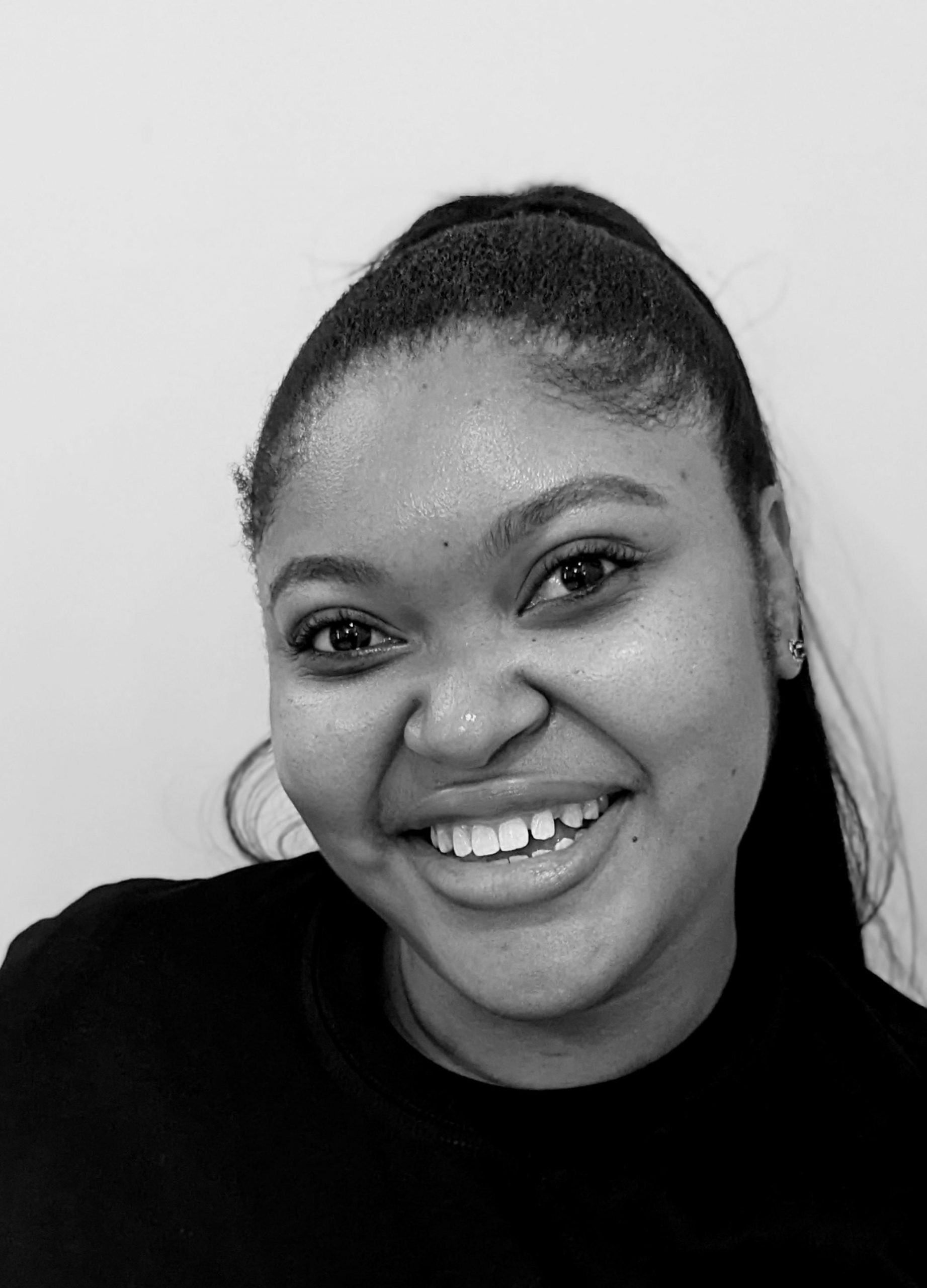Best Practices for E-Commerce Pricing Strategy
Glory-Anna Oshafi
Finding the sweet price spot for both your customers and your business is the most effective way to ensure your business continually stays afloat.
In highly competitive industries, the prices attached to your brand’s products or services can make all the difference between growing your customer base and falling off the industry wagon. A good 94.17% of customers in a study by Namogoo chose “price” as the number one factor influencing their decision to make an online purchase.
So, if your price does not match customers’ budgets, you lose more than half of your potential buyers. Thus, knowing how to set your pricing to favor both you and your customers is essential.
If the price is too high, you chase potential buyers away, and if it’s too low, your company may significantly lose out on revenue to be generated.
In this e-commerce pricing guide, we share tips and best practices to employ when fixing prices for your brand’s products and services. Read on to glean the details that will help you quickly improve your customer acquisition rates.

What Is an E-Commerce Pricing Strategy?
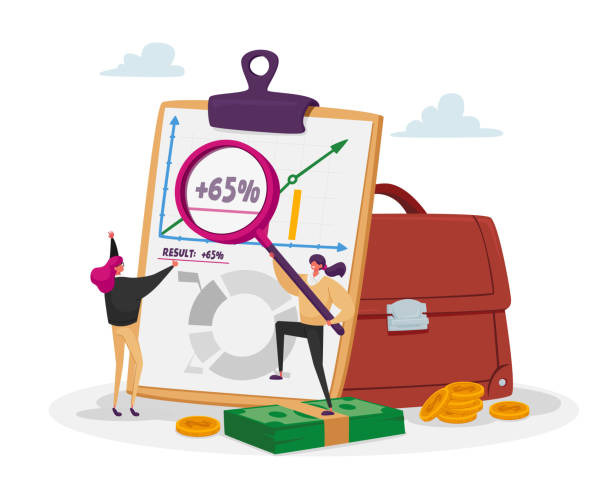
An e-commerce pricing strategy is simply a well-laid-out structure that a brand uses to set prices for its products or services. There are a variety of e-commerce pricing strategies, each unique for the type of products or services that a company offers, how popular the demand is for that product or service, and how your competition has fixed its own prices.
Other factors that you can consider when crafting your e-commerce pricing strategy include the cost of producing or manufacturing the product or service, your brand’s operational and advertising cost, your revenue goals — comprising the lifetime value of your customers, and the average order value you usually receive.
Choosing a random, impractical figure as your price range will most likely not assist you in achieving your brand’s revenue goals. You must keep abreast with market trends, consumer needs, and your business needs to consistently make informed decisions and maintain a working pricing model.
Why Is Pricing Strategy Important for E-Commerce?
Your pricing strategy is key and relevant for your brand because it helps you decide how to set a price that makes you the most revenue while also being affordable and attractive to consumer budgets.
It will help you survive in your niche market and even make you a worthy competitor among top brands. There are many more reasons why it’s essential that your company creates its own pricing strategy; let’s see a few of them below:
- It helps you determine how much profit your company can aim to generate over a period of time. With the right pricing, you can make the most of your sales and profit margins, creating a long span of sustainable company growth.
- A well-priced product or service can give you the upper hand over your competitors, helping your brand stand out and appeal to a larger variety of customers. It also creates the perception that your brand provides value and quality offerings, endearing you to the hearts of consumers.
- It’s a significant way to attract, acquire, and retain your customers. With over 94% of consumers being price-sensitive when shopping online, a great price will boost customer loyalty, leading to repeat purchases.
- Depending on your pricing strategy, you can position yourself in the market as the authority brand for different budget capacities — including luxury, pocket-friendly, or great value prices. The pricing model you set will help you attract customers who seek luxury, wallet-friendly, or somewhere in between.
- In the ever-changing market economy, your pricing strategy will determine how quickly you can adapt to hikes or dips in demand and supply, customer choices, and competitor pricing. Your quick response to these changes keeps your brand competitive and profiting optimally.
Key Components of an Effective E-Commerce Pricing Strategy
The key components of an effective e-commerce pricing strategy function together to help you achieve your desired pricing model. Here are a few key components that your pricing strategy must contain:
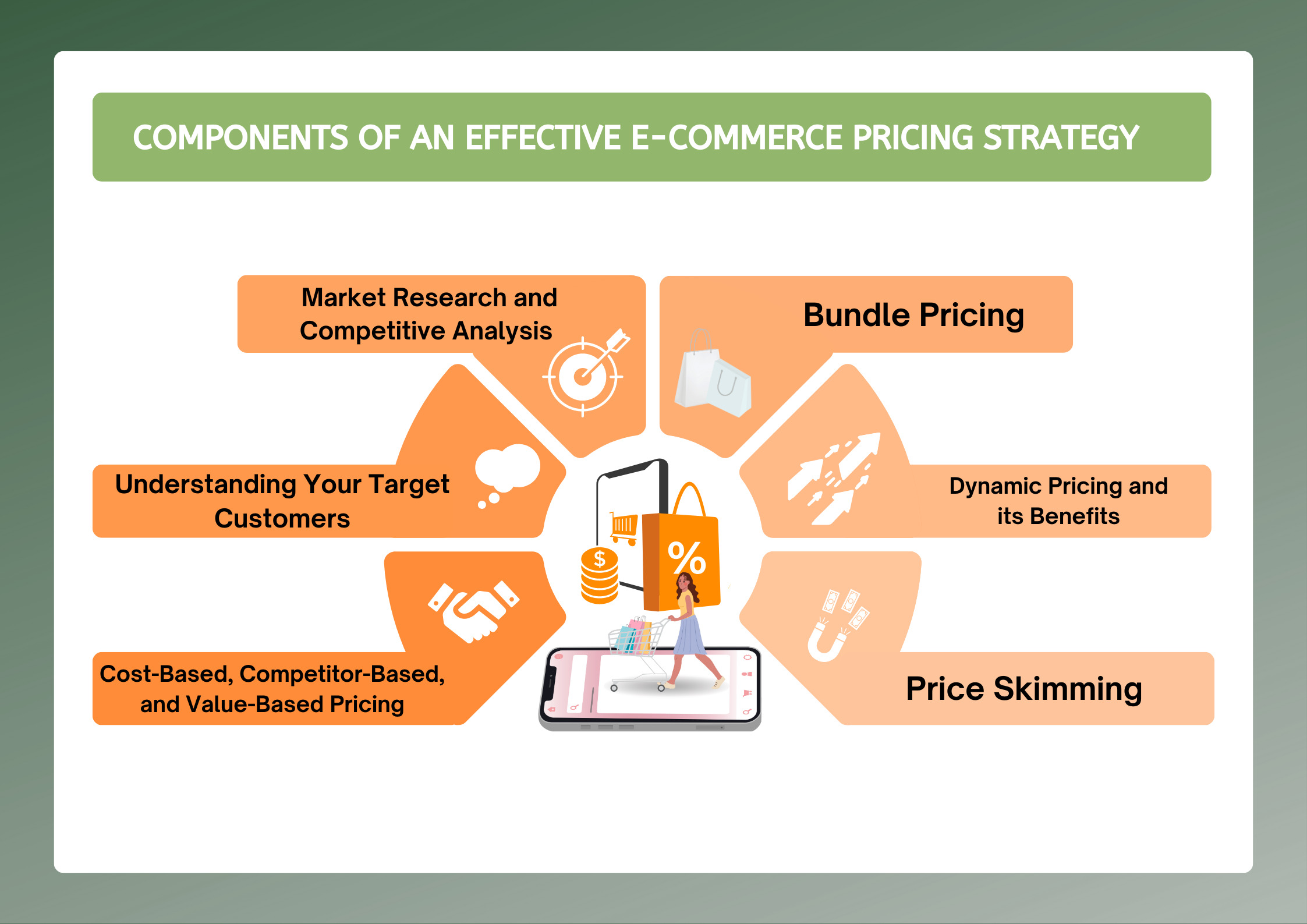
Market Research and Competitive Analysis
Conducting thorough market research when setting your pricing strategy helps gather data about your intended customers, what they like, how they make purchases, and how sensitive they are to prices. Knowing what they need and expect from a business will help you create a pricing model that fits well with their values.
It gives you a beforehand idea of how much your customer can possibly pay for a product. Say, for instance, you’re about to open an e-commerce store for custom-branded clothing; it’s expected that you conduct market research on your competitors to see how much their customers pay for related items.
- How do they charge when a customer wants to buy two branded T-shirts? Or how do they set the price for a bulk order of t-shirts with print-on-demand services?
- Are there any discounts when customers refer their friends?
- Does the price per item adjust when a customer is paying for a shirt + shorts bundle, instead of just shorts?
- How often do they run sales?
Research eliminates the guesswork by providing you with raw data. It gives you a quick glimpse into how competitors fix their pricing levels, the discount strategies they use to attract customers, and what other value they provide in addition to their products and services. Knowing all of this will help in your decision-making so that you don’t set a price that is below market standard or too high for your target market.
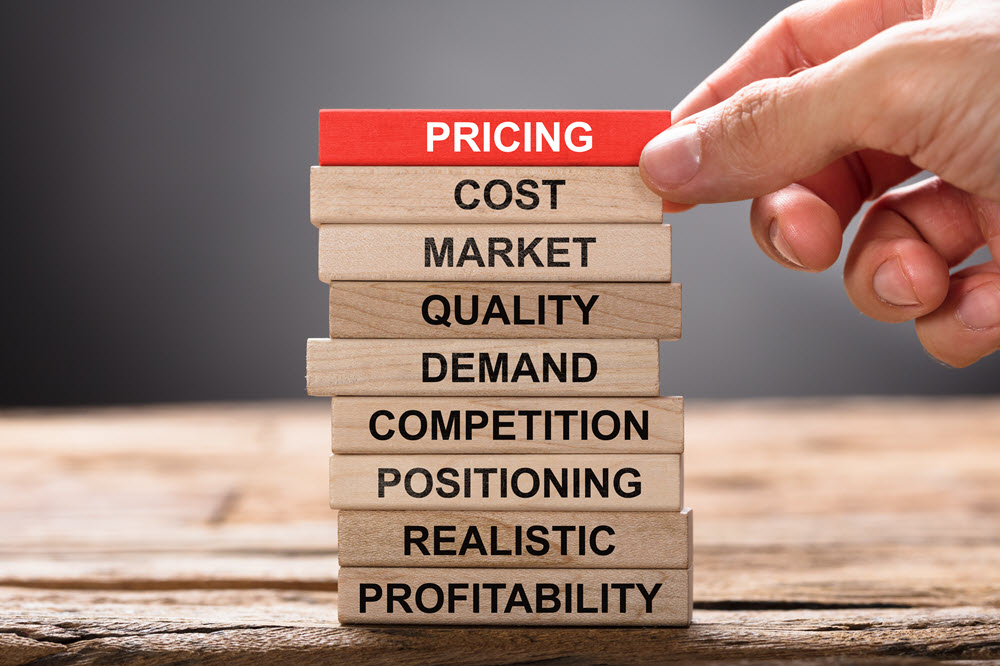
Understanding Your Target Customers
As explained earlier, understanding your target customers gives you a deeper idea of what drives them to make a purchase. It clues you in on how much worth they place on your products or services. It even gives you an idea of what features or functions in your products or services are important to them, helping you modify your strategy to meet up with that value.
For instance, if you sell athleisure clothing online, understanding your customers can help you identify what matters most to them when they buy items. For some, it may be the quality of the fabric they find beneficial; for others, it may be because the outfit comes in various colors. For example, the athleisure market in 2023 has seen a shift towards sustainable and eco-friendly materials, impacting how consumers perceive value. If your brand aligns with these trends, it can significantly influence your pricing strategy.
Whatever the case, your knowledge of this will help you set prices based on the benefits your customers believe they’ll gain when they shop from you. Feedback and reviews are some of the best ways to collect such essential data.
Again, knowing your customers helps you assess their price sensitivity. Are your customers willing and able to pay more if they sense an added value attached to a product? This gives you a clue on the pricing format or packages you should offer.
It also tells you which segments your customers fall into, based on their purchase history, behavior, demographics, and even preferences. All the above can also help you determine how much lifetime value they can add to your business, so you can jealously safeguard and prioritize high-value customers.
Cost-Based, Competitor-Based, and Value-Based Pricing
These are three vital types of pricing strategies. They’re quite simple to adopt. However, they each have their benefits as well as things to consider. Let’s quickly examine each:
Cost-Based
Cost-based Pricing is a pricing strategy where you fix prices based on the costs of production, manufacturing, or purchasing your products or services, just like the name implies. It’s also known as cost-plus pricing or breakeven pricing.
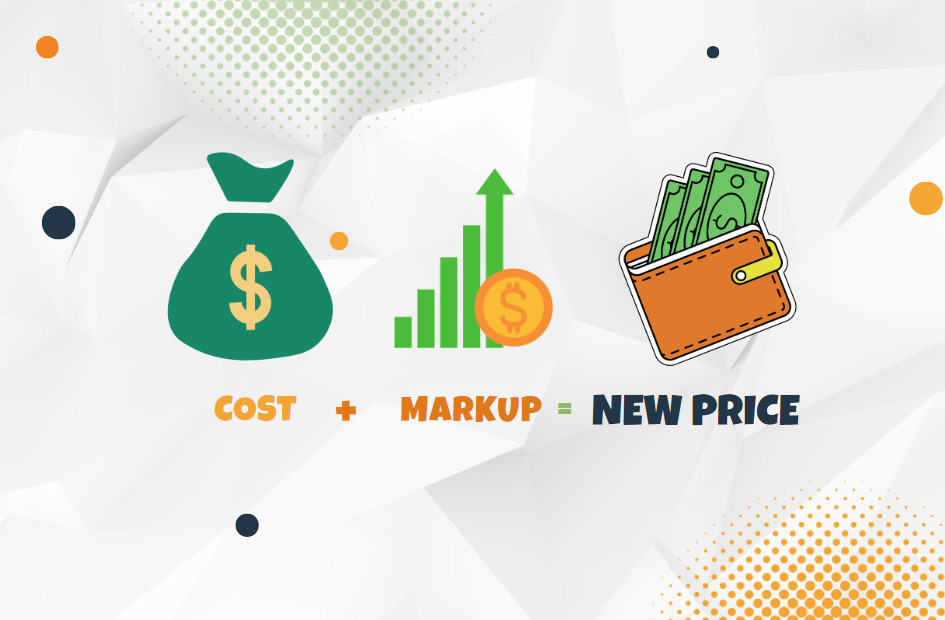
In this pricing model, the business simply aims to ensure that the prices are set to cover the cost of production or purchase and still yield some desirable profit. You simply include an additional amount to the initial cost of production or purchase to create your selling price.
For this model, it’s essential that you do a thorough calculation of the entire amount put into the production of the goods or services so that you don’t overcharge or undercharge yourself.
For instance, say you purchase jewelry on Etsy to resell on your online store. Since you’re not producing the jewelry, your major cost here is the amount paid for purchasing the products. But don’t forget additional costs like customer shipping fees, advertising fees, and maybe even web hosting fees for your e-commerce website when you’re calculating.
Competitor-Based
Competitor-based Pricing, on the other hand, is where you set your prices based on the existing competitor prices on the market. Usually, to gain more price-sensitive customers over the competition, you can fix your products and services at a slightly lower price than what they’re offering. If you already have a strong customer base, you can set your prices similar to or in line with the competition’s prices.
Let’s look at two popular competitors, Sephora and Ulta Beauty. Both e-commerce platforms carry the same product. However, Sephora charges slightly higher for the same product size than Ulta Beauty.
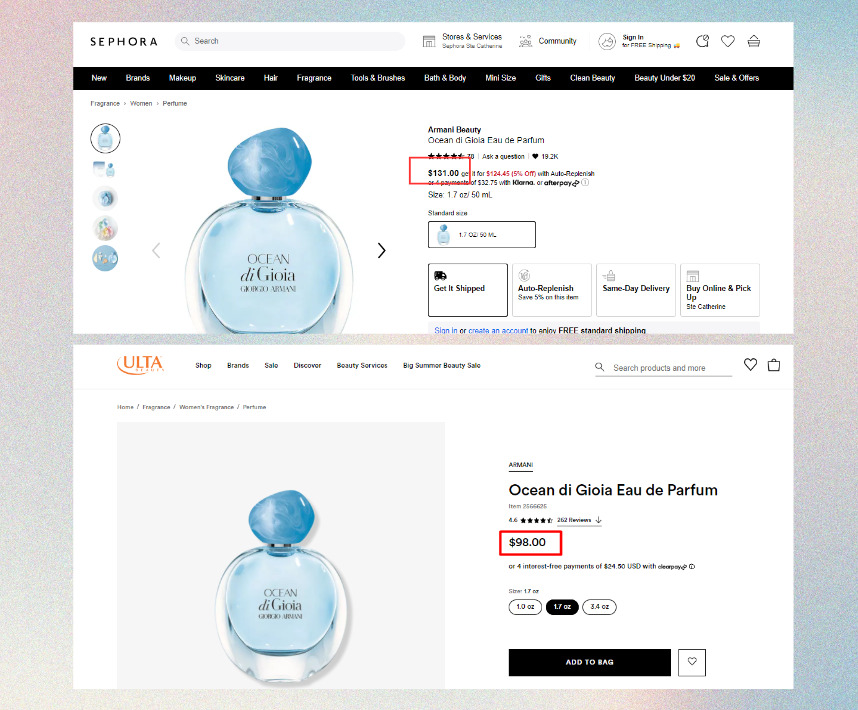
Sephora is a well-established brand with a chic luxury vibe that appeals to higher-end customers’ pockets. On the other hand, Ulta Beauty prices its products to be affordable to pocket-friendly or price-sensitive customers.
To accurately work with a competitor-based pricing strategy, you’ll need to conduct market research and competitor analysis, monitoring your competition to figure out the way they set their prices.
When you observe any changes, you also make similar price changes. This strategy aims to gain an advantage over your competitors and a larger market share by providing your customers with similar or better-value products and services at matching or lower prices.
Value-Based Pricing
Value-based pricing is based mainly on the value customers perceive a product or service provides. It does not only consider the cost at which the product or offering is purchased or the price that the competition has set but also the value the customer has placed on the product.
For instance, you may find casual Nike sneakers being sold cheaper than a pair of classy pointed-toe pumps from Jimmy Choo that come in a unique color. This is because female customers attribute more value to the pumps than the sneakers based on many factors, including uniqueness, brand reputation, quality, and more.

To leverage this pricing strategy, you must be very familiar with your customers’ preferences, and you should be adept at communicating the value of the product you’re offering in such a way that it justifies the price you have fixed for your products.
Dynamic Pricing and Its Benefits
Dynamic pricing is a more complex pricing strategy that leverages an algorithm to adjust prices based on purchase activity within a period. It’s more popular than you think, though.
As of 2023, dynamic pricing has evolved with more sophisticated algorithms capable of real-time market analysis. This makes it an even more powerful tool for e-commerce businesses, especially in sectors like fashion and electronics, where market trends can shift rapidly.
If you’ve ever hailed a ride on Uber or other ride-sharing platforms when it is raining or after a popular event and you notice that the ride fare has suddenly tripled, then you have experienced dynamic pricing.
The cost of the trip varies based on the availability of drivers in the area and the demand for rides by ridesharers. So when there’s a high ride demand after a concert, ride fares within that area automatically go higher. On a regular day, the fare will be a regular fair price.
For smaller e-commerce businesses, dynamic pricing may be better for services or personalized products that typically require a price quotation. This is because customers already expect that the price will be different from normal because of the specific project or situation being paid for.
Dynamic pricing is also known as real-time or demand pricing. Other factors that may affect the fluidity of the dynamic pricing strategy include customer behavior and competitor prices.
Some benefits of dynamic pricing:
- Being able to generate maximum value from customers, boosting your overall revenue.
- Gaining the upper hand over the competition, as you can respond swiftly to their pricing changes.
- Providing personalized pricing to customers depending on their loyalty, behavior, and preferences.
- Flexibility in the fast-paced, rapidly changing world of e-commerce, for instance, during inflations, market fluctuation, unforeseen trends, and more.
Bundle Pricing
This pricing strategy does two things: It attracts customers and boosts sales in highly competitive industries. The bundle pricing strategy works by creating a “bundle” of products or services that complement each other and sell both together at a reduced price.
If you shop on Amazon, you will see this frequently. A toaster and a blender may be sold at $35 and $50, respectively, totaling $85 if sold separately. However, a bundled offer will pair those two items and sell them at a total of $75. Here is just another example below:

One of the quickest ways to create bundle-priced goods is to identify your best-selling or fast-selling products or services. Combine them with slow-selling products, and you have a bundle. This pricing strategy is great at moving sales because of the “saving” value it gives customers.
In the example above, you’ll be happy to save $10 and get two items at once, instead of buying them separately for a higher price. It’s a fast way to clear up your old stock and make room for incoming products.
Price Skimming
This is another popular strategy where brands set the maximum price for an item and then reduce the price over time. It’s typically used in the tech e-commerce world or industries where they often have major releases like automobiles.
Remember paying $999 for the latest Macbook Air in 2015, and then five years later, the price for that Macbook had significantly dropped? That’s price skimming. Apple and other companies use price skimming to target customers willing to pay a premium for the latest tech release.
When the demand for a product decreases, it is essential to lower its price to attract price-sensitive customers. In doing so, you can convert these customers who are more concerned about affordability than having the latest gadgets.
The benefit of price skimming is that the initial hyped-up prices, which early buyers do not mind paying for, help to cover the product’s production cost quickly.
Best Practices for Setting Your E-Commerce Pricing Strategy
Ready to set up your own e-commerce pricing strategy? Follow these best practices for optimal results.
Know Your Margins and Costs
Never set a price range for your products without determining your costs. Get an accurate knowledge of your production, marketing, shipping, and overhead costs to ensure you don’t underprice your goods.
Let’s break it down. The components encompassed under “costs” include:
- Direct costs: This includes the costs of raw materials, manufacturing, packaging, and shipping.
- Indirect costs: Marketing and advertising, salaries, rent, software fees or subscriptions, utilities, and other fees necessary for running your business.
- Overhead costs: Office supplies, admin costs, insurance, legal fees, and other costs needed for business operations
Without a complete overview of costs, you may miss out on some expenses and underprice your products. This will result in an insignificant or non-existent profit margin, even after making sales.
Your “margin” is the difference between the selling price of your product and the cost at which you procured or manufactured it. Knowing this margin is useful in making pricing decisions and ensuring you generate profit from your sales.
Understand Your Competitors
By understanding who your brand is up against, you’re better informed on how to stand out in the market. It helps you set competitive prices that will attract your customers and highlight the unique value your brand has to offer — quality, brand reputation, affordability, or more.
It also gives you insight into the market trends and industry standards, helping you better understand what your customers expect from you in terms of pricing. Your prices will not be absurdly high or suspiciously low, which may deter clients.
Understanding your competitors can also teach you areas where you can gain a competitive advantage over them. You can use your findings to identify areas where you can offer more value, lower prices, or better quality, all in a bid to gain a larger market share.
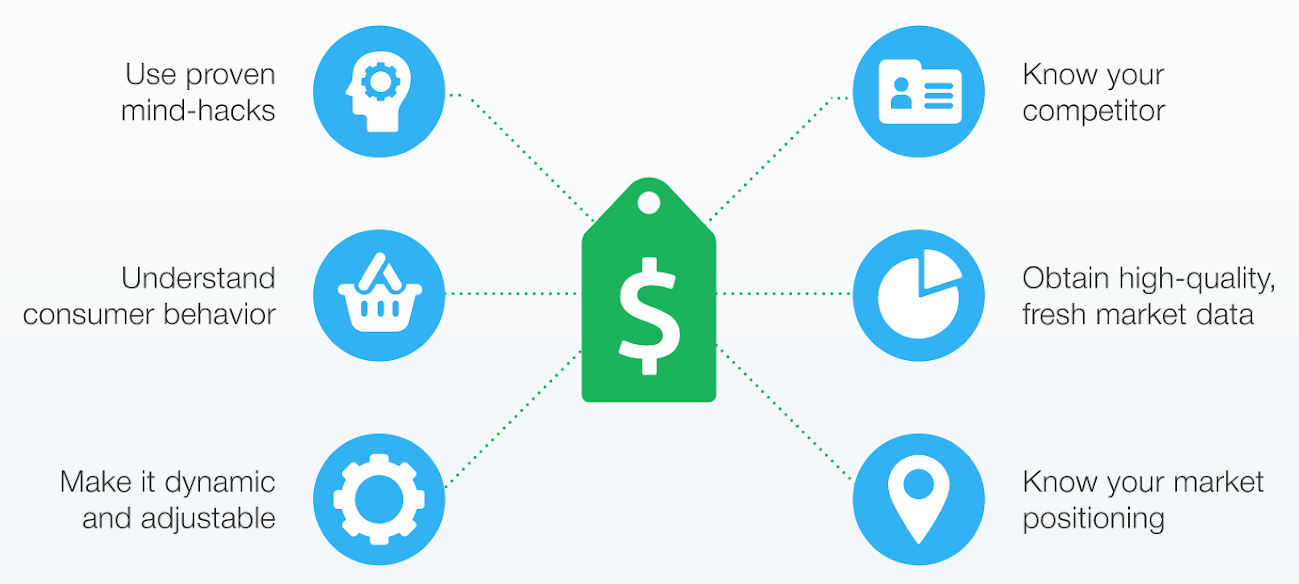
Deliver Value, Not Just Low Prices
Customers love low prices, yes, but they also gravitate toward brands that offer them value for their money. It means low prices will not always attract customers if they feel your products are subpar.
Identify and then clearly articulate the unique value that your products offer customers. Discover their unique needs and problems, and create products that cater to them. Let your unique value proposition align with your pricing strategy so that customers know exactly what they’re paying for.
Keep Testing and Optimizing Prices
Fixing an e-commerce pricing strategy and calling it a day is taking a step toward low sales. You must continuously experiment with various strategies to understand their impact on your sales. One way of experimenting is the A/B testing method (comparing two different pricing strategies on the same product), which helps to determine which generated higher sales.
You can also try bundling pricing or dynamic pricing strategies based on your business products to see what works. Frequently review your strategy based on success, market trends, customer feedback, business goals, and more to ensure you fully maximize sales opportunities at every step.
Conclusion: Taking Action on Your E-Commerce Pricing Strategy
Crafting an effective pricing strategy for your e-commerce business isn’t just about setting prices; it’s about understanding the market, your customers, and how your products fit into this dynamic landscape. As we’ve explored various pricing strategies, remember that the key to success is continual adaptation and responsiveness to market changes.
But where do you go from here? Let’s break it down into actionable steps:
Your Next Steps: Implementing a Winning Pricing Strategy
- Conduct a Market Analysis:
- Research current market trends and consumer behaviors.
- Analyze your competitors’ pricing strategies.
- Understand the economic factors influencing your target market.
- Know Your Costs Inside and Out:
- Calculate your total costs, including production, marketing, and overhead.
- Ensure your pricing covers these costs and leaves a margin for profit.
- Understand Your Customer:
- Identify your target demographic and their spending habits.
- Gather feedback and conduct surveys to understand what drives their purchasing decisions.
- Choose Your Pricing Strategy:
- Decide whether cost-based, competitor-based, or value-based pricing suits your products best.
- Consider dynamic pricing if your market is highly variable.
- Test and Adjust:
- Implement your chosen strategy on a small scale to gauge its effectiveness.
- Use customer feedback and sales data to refine your prices.
- Monitor Continuously:
- Keep an eye on market trends and competitor strategies.
- Regularly review and adjust your pricing to stay competitive.
- Communicate Value Clearly:
- Ensure that your marketing communicates the value of your products effectively.
- Align your pricing with the perceived value to justify it to your customers.
- Leverage Technology:
- Utilize pricing software or tools for real-time pricing adjustments (if applicable).
Quick-Start Checklist

- Market Analysis Completed
- Total Costs Calculated
- Customer Understanding Enhanced
- Pricing Strategy Selected
- Initial Testing Done
- Monitoring System Set Up
- Value Communication Strategies Developed
- Technology Tools Evaluated
By following these steps and using this checklist, you can create a pricing strategy that not only meets your business goals but also resonates with your customers. Remember, the most successful e-commerce businesses are those that are flexible, responsive to change, and always in tune with their customers’ needs.

